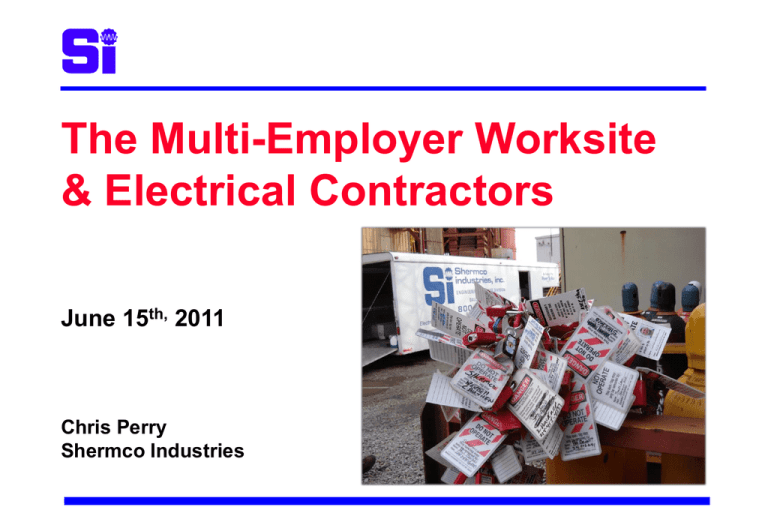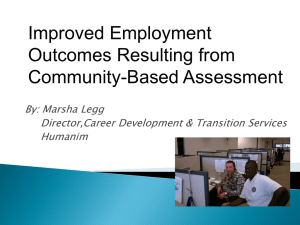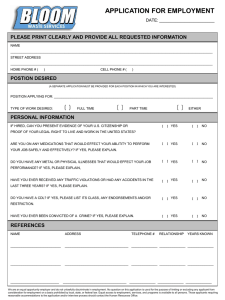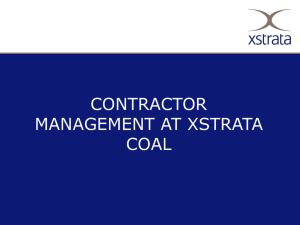Wed-T3-130-ChrisPerry
advertisement

The Multi-Employer Worksite & Electrical Contractors June 15th, 2011 Chris Perry Shermco Industries Topics for Today • Electrical Worker Statistics • OSHA & The Multi-Employer Worksite Program – – – – “The Program” Regulatory Responsibilities Legal Responsibilities Reality • Qualifying Your Electrical Contractors 2 Electrical Injury Statistics Annual Electrical Injury Facts • Average of 4,000 non-disabling electrical contact injuries annually in the United States Annual Electrical Injury Facts • Average of 3,600 disabling electrical contact injuries annually in the United States Annual Electrical Injury Facts – Annually - Approximately 400 electrical fatalities Annual Electrical Injury Facts • Over 2,000 workers are sent to burn centers each year with electrically-related burn injuries What Does OSHA Think? • The OSHA MultiEmployer Citation Policy states that “both construction and nonconstruction citations shall be issued to employers whose employees are exposed to hazards”. What Is Reality? • As an owner or controlling employer, you can be held financially liable for injuries to third parties. Contractor Liabilities As a worksite owner you can be cited and fined for your electrical contractors violations in multiple roles: Controlling Employer Creating Employer Exposing Employer Correcting Employer Contractor Liabilities As a worksite owner you can be cited and fined for your electrical contractors violations in multiple roles: Controlling Employer Any employer that has sufficient “control” over a multi-employer workplace to cause hazardous conditions to be abated may be cited for failing to do so if that employer had knowledge of the hazard and there is a reasonable likelihood that employees over whose work practices it exercised direct control, or had the right to exercise direct control, could have been exposed to the hazardous conditions. Contractor Liabilities As a worksite owner you can be cited and fined for your electrical contractors violations in multiple roles: Creating Employer Any employer in a multi-employer worksite that causes a hazardous condition to be created may be cited if it has knowledge of the hazard and there is a reasonable likelihood that employees, over whose work practices it has direct control, or the right to exercise direct control, could have been exposed to the hazardous condition. Contractor Liabilities As a worksite owner you can be cited and fined for your electrical contractors violations in multiple roles: Exposing Employer Any employer in a multi-employer workplace may be cited if it exposes employees over whose work practices it has direct control, or the right to exercise direct control, to hazards of which it has knowledge. Contractor Liabilities As a worksite owner you can be cited and fined for your electrical contractors violations in multiple roles: Correcting Employer Is responsible for correcting any violations or hazardous conditions at the worksite. The correcting employer must exercise reasonable care in preventing and discovering violations and meet its obligations of correcting the hazard. Penalties • Penalties are appropriately calculated, using the exposed employees of all employers as the number of employees for probability assessment. Penalties • Lawyers are next in line to collect. Legal implications can be disastrous for a small business and extremely taxing on large employers. – – – – – Legal defense fees Court costs Medical bills Lost wages Not to mention bad PR Reasonable Care • Once your contractors are on site, you have to continue to inspect the worksite, ask questions, look for hazards, communicate & mitigate any hazards found • There must be some “Reasonable Care” evident Reasonable Care • “Reasonable Care” is the legal obligation imposed on an employer requiring that they adhere to a standard of reasonable care to foresee hazards that could potentially harm others Reasonable Care • Factors that affect how frequently and closely a controlling employer must inspect to meet its standard of reasonable care include: – How much the controlling employer knows both about the safety history and safety practices of the employer it controls and about that employer's level of expertise. – How much he enforces the other employer's compliance with safety and health requirements Reasonable Care • Factors that affect how frequently and closely a controlling employer must inspect to meet its standard of reasonable care include: – How much he enforces the other employer's compliance with safety and health requirements with an effective, graduated system of enforcement and follow-up inspections Reasonable Care • In short you have to keep an eye on the site and on each and every contractor • Note changes with each contractors “Turnover” in their workforce OSHA & Electrical Safety • OSHA requires that qualified electrical workers be trained in: – Skills and techniques to determine energized parts from others – Skills and techniques to determine nominal voltage – How to determine minimum safe approach distances for shock – Use of special precautionary techniques, use of PPE, use of blankets and shielding, and use insulated hand tools OSHA & The Electrical Worksite • Electrical Workers must be “Qualified” – 29CFR1910.269 “One knowledgeable in the construction and operation of the electric power generation, transmission and distribution equipment involved, along with the associated hazards”. OSHA & The Electrical Worksite • 29CFR1910.269(c) “The employer shall ensure that the employee in charge conducts a job briefing with the employees involved before they start each job”. OSHA & The Electrical Worksite • 29CFR1910.269(c)(1) “Additional briefings shall be held if significant changes, which might affect the safety of the employees, occur during the course of the work”. Electrical Contractors Know The Qualifications Of Your Contractor! The Contractor & Owner Relationship • Electrical contractors are usually recognized by the owner as “knowledgeable” and usually give the owner the impression that “they know what they are doing” • Owners have a tendency to trust them completely based off of the contractors tenure on site, manpower, capabilities and long time personal relationships The Contractor & Owner Relationship • Owners feel that the contractors are “experienced”, but seldom question the qualifications of the foreman or other employees of the contracting company. • If safety challenges do arise, owners are resistive to change while midcourse of a project due to costs, lost time, or contractual barriers The Contractor & Owner Relationship • As an owner you should: – Obtain a copy of the health & safety information of the contracting company – Ask Questions of all the electrical workers about electrical hazard identification & mitigation – Be involved in the contractors Hazard Risk Analysis/ Job Safety Analysis process – Inspect the contractors tools and equipment for calibration, serviceability and “prior use” The Contractor & Owner Relationship • As an owner you should: – Training documentation – Always note the following: • Dates of training, should be annual at a minimum • Length of the training program • Instructing company or individual, make sure he has a reasonable history of instruction • Course curriculum, needs to be some hands on and proof of proficiency The Contractor & Owner Relationship • As an owner you should: – Electrical Safety Program – Get a copy of their program! – Inspect for policy & procedures for: • • • • • • LOTO Project pre-planning Safe work practices Hazard identification Switching of equipment Energized work Always Stay Grounded Summary • Protection of electrical workers is paramount, especially with the declining workforce • New electrical workers moving into the workforce lack many of the basic skills need to work safely • Know your contractor, develop a lasting relationship & don’t let money come between you • OSHA’s world is changing politically, this could have disastrous consequences • With that said, the burden is on the owner even more to qualify who comes into the worksite 34 Questions? Chris Perry Shermco Industries www.shermco.com Phone: 888-SHERMCO








